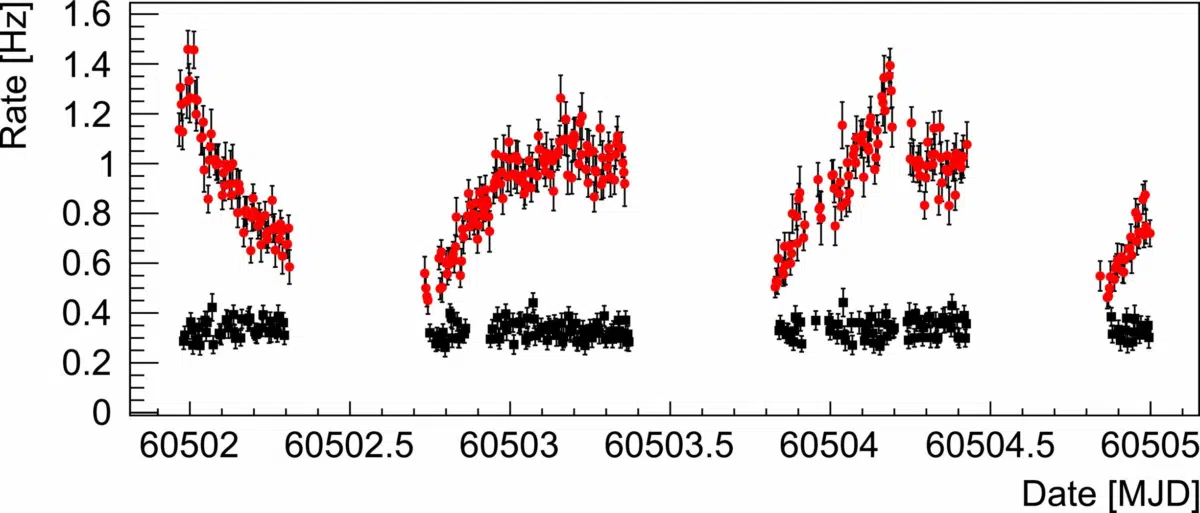A balloon-borne telescope has captured one of the most precise glimpses yet of the chaotic environment around a black hole. Suspended in the upper atmosphere, the experiment focused on Cygnus X-1, a well-known stellar-mass black hole. Instead of imaging it directly, scientists studied the light’s polarization to unlock its secrets. These findings provide new tools to investigate the behavior of matter in extreme gravity.
A Telescope Above the Clouds Opens a New Window on Black Hole Physics
High above Earth’s atmosphere, a balloon-based telescope known as X-Calibur has taken an unprecedented look into the X-ray emissions from Cygnus X-1, one of the brightest X-ray sources in the sky and a black hole system first discovered in 1964. The results, published recently in The Astrophysical Journal, offer critical insight into how matter behaves just before it disappears into the gravitational abyss.
Rather than using traditional imaging techniques, researchers focused on X-ray polarization, which reveals how the light waves are oriented after interacting with magnetic fields and other material near the black hole. This polarization offers clues about the geometry and behavior of the accretion disk—the swirling plasma funneling into the black hole.
“The observations we made will be used by scientists to test increasingly realistic, state-of-the-art computer simulations of physical processes close to the black hole,” said Henric Krawczynski, the Wilfred R. and the project’s principal investigator.
This new data will help bridge the gap between theory and observation, something that has remained elusive in black hole astrophysics for decades.
Seeing Without Seeing: Why Polarization Matters in Black Hole Studies
Unlike images from optical telescopes, X-ray polarimetry doesn’t show a “picture” of a black hole. Instead, it measures how light behaves after extreme interactions with matter and gravity. This indirect method is especially useful in the case of Cygnus X-1, whose visual signal is barely distinguishable.
“If we try to find Cyg X-1 in the sky, we’d be looking for a really tiny point of X-ray light,” said Jingwei Gau, one of the lead researchers on the project. “Polarization is thus useful for learning about all the stuff happening around the black hole when we can’t take normal pictures from Earth.”
The balloon mission complements space-based observatories like NASA’s Imaging X-ray Polarimetry Explorer (IXPE). These combined datasets allow astrophysicists to detect patterns and compare models that simulate the interaction of high-energy radiation with plasma and magnetic fields under extreme gravitational conditions.
“Combined with the data from NASA satellites such as IXPE, we may soon have enough information to solve longstanding questions about black hole physics in the next few years,” added Krawczynski.
These questions include how black holes grow, how jets are launched from their poles, and how magnetic fields interact with infalling matter.
 On-source (red circles) and off-source/background (black squares) events, of energies between ∼19 and 64 keV and arriving in the polarimeter detectors, passing the analysis cuts described in Section 2.2. Time bins of duration no longer than 300 s are used. The daily gaps between Cyg X-1 observations were used for observing the Crab (H. Awaki et al. 2025). Smaller variations within each day (for example, the drop in the third observation) are generally correlated with changes in the elevation of the source.
On-source (red circles) and off-source/background (black squares) events, of energies between ∼19 and 64 keV and arriving in the polarimeter detectors, passing the analysis cuts described in Section 2.2. Time bins of duration no longer than 300 s are used. The daily gaps between Cyg X-1 observations were used for observing the Crab (H. Awaki et al. 2025). Smaller variations within each day (for example, the drop in the third observation) are generally correlated with changes in the elevation of the source.
A New Frontier in High-Altitude Astronomy
The success of the X-Calibur mission shows that balloon-based astronomy—a relatively low-cost, high-impact method—is more than a proof of concept. By rising above 99.5% of Earth’s atmosphere, such telescopes can avoid the distortions and absorption that hinder ground-based observatories, particularly in the high-energy X-ray band.
The mission required precise timing and coordination, launching from Esrange Space Center in Sweden and flying over the Arctic to Canada. It gathered nearly two weeks of uninterrupted X-ray data, allowing researchers to measure the changing polarization as the black hole system rotated. This rotation offered a natural laboratory to observe different perspectives of the accretion process.
These findings may influence future missions and help design even more sensitive instruments capable of monitoring multiple black hole systems simultaneously. The potential to map how energy and matter behave under relativistic conditions could push the field closer to testing Einstein’s predictions in some of the universe’s most extreme environments.
A Step Closer to Solving Cosmic Mysteries
While the idea of studying something inherently invisible like a black hole might seem paradoxical, scientists are rapidly learning how to read the imprints these objects leave behind. From the bending of light near the event horizon to the subtle twisting of X-ray waves, black holes shape their environment in measurable ways.
Thanks to X-Calibur and similar projects, a more complete picture is emerging—one that could ultimately redefine our understanding of gravity, spacetime, and the life cycle of stars. As technology and observation strategies evolve, the next decade could mark a transformative era for black hole research.

